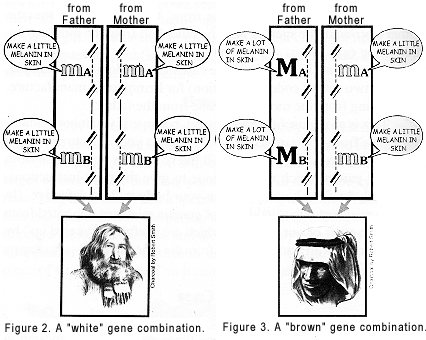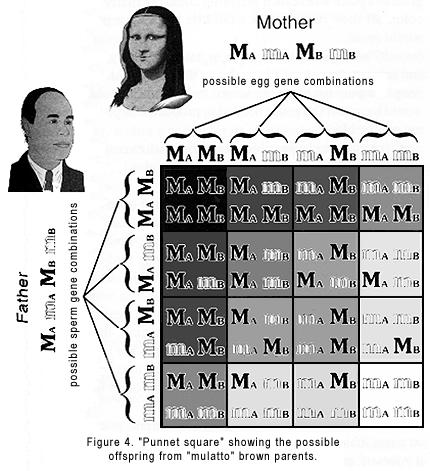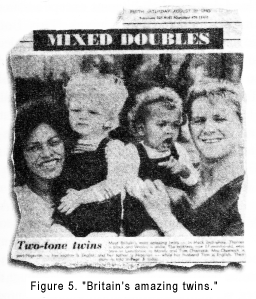|
|
|

What makes people have different skin "colors"?
Answer...
|
As was discussed in Where did the human races come from?, we learned
that all humans on earth today are descended from Noah and his wife, his
three sons and their wives, and before that from Adam and Eve (Genesis
1-11). But today we have many different groups, often called
"races," with what seem to be greatly differing features. The
most obvious of these is skin color. Many see this as a reason to doubt
the Bible's record of history. They believe that the various groups
could have arisen only by evolving separately over tens of thousands of
years. However, as we shall see, this does not follow from the
biological evidence.
Skin
Color
We know that skin color is governed
by more than one pair of genes. For simplicity, let's assume there are
only two, 1 located at positions A and B on the chromosomes.
One form of the gene, "M," "says" to make lots of
melanin; another form of the gene, 2 "m," says to
only make a little melanin. At position A we could have a pair such as MAMA,
MAmA, or mAmA 3
which would instruct the skin cells to make a lot, some, or little
melanin. Similarly, at position B we could have the gene pairs MBMB,
MBmB, or mBmB instructing
cells to make a lot, some or little melanin. Thus very dark people could
have MAMAMBMB, for example
(see figure 1).
Since both the sperm and eggs of such
people could only be MAMB, (remember, only one of
each A or B pair goes to each sperm or egg) they could only produce
children with exactly the same combination of genes as themselves. So
the children will all be very dark. Likewise, very light people, with mAmAmBmB,
could produce children only like themselves (see figure 2, below).

Let's look at what combinations would
result from parents who are the type of brown-skinned person called a
mulatto, or MAmAMBmB (the
offspring of an MAMAMBMB and
mAmAmBmB union, for example;
see figure 3, below).

We can do this with
a diagram called a "Punnet square" (see figure 4 below).

The left side (of the above table)
shows the four different gene combinations possible in the sperm from
the father and the top gives the combinations possible in the eggs from
the mother (remember that a parent can only pass on one of each pair of
genes to each sperm or egg). We locate a particular sperm gene
combination and follow the row across to the column below a particular
egg gene combination (like finding a location on a street map). The
intersection gives the generic makeup of the offspring from that
particular sperm and egg union.
For example, an MAmB
sperm and an mAMB egg would produce a child with MAmAMBmB,
just the same as the parents. The other possibilities mean that five
levels of melanin (shades of color) can result in the different
offspring of such a mulatto marriage, as roughly indicated by the level
of shading in the diagram. If three gene pairs were involved, seven
levels of melanin would be possible.
Thus a range of
"colors," from very light to very dark, can result in a single
sgeneration, beginning with this particular type of mid-brown
parents.
If people with MAMAMBMB
, who are "pure" black (in the sense of having no genes for
lightness at all), were to intermarry and migrate to a place where their
offspring could not marry other people of lighter color, all their
descendants would be black -- a pure "black line" would
result.
If "white" people (mAmAmBmB)
were to marry only other whites and migrate to a place where their
offspring could not marry darker people, a pure (in the same sense)
"white line" would result -- they would have lost the genes
needed to produce a large amount of melanin and be black.
It is thus easily possible, beginning
with two middle-brown parents, to get not only all the
"colors," but also people groups with stable shades of skin
color.
But what about people groups that are
permanently middle-brown, such as we have today? Again, this is easily
explained. If those with genes MAMAmBmB
or mAmAMBMB no longer
intermarry with others, they will be able be able to produce only
mid-brown offspring as in figure 3. (You may want to work this out with
your own Punnet square.)
 If
either of these lines were to interbreed again with the other, the
process would be reversed. In a short time, their descendants would show
a whole range of colors, often in the same family. Figure 5 shows what
were called Britain's most amazing twins. One is obviously quite light
in complexion, while the other is clearly darker skinned. If
either of these lines were to interbreed again with the other, the
process would be reversed. In a short time, their descendants would show
a whole range of colors, often in the same family. Figure 5 shows what
were called Britain's most amazing twins. One is obviously quite light
in complexion, while the other is clearly darker skinned.
Of course, this is not amazing at all
when you do the exercise on paper, based on what we have discussed. (A
clue if you want to do it yourself: mother cannot be MAMAMBMB.
Also, the twins are obviously not identical twins, which are derived
from the same egg -- that is, monozygous).
If all the people on earth were to
intermarry freely, and then break into random groups that kept to
themselves, a whole new set of gene combinations could emerge. It may be
possible to have almond eyes with black skin, blue eyes with black,
tightly curled hair, etc. We need to remember, of course, that the way
in which genes express themselves is much more complex than this
simplified picture. For example, sometimes certain genes are linked
together. However, the basic point is unaffected.
Even today, within a particular
people group you will often see a feature normally associated with
another people group. For instance, you will occasionally see a European
with a broad flat nose, or a Chinese person with very pale skin or
Caucasian eyes. Most scientists now agree that, for modern humans,
"race" has little or no biological meaning. This also argues
strongly against the idea that the people groups have been evolving
separately for long periods.
What
Really Happened?
We can now reconstruct the true
history of the people groups, using:
- The
information given by the Creator himself in the Book of Genesis.
- The
background information given above.
- Some
consideration of the effect on the environment.
The first created
man, Adam, from whom all other humans are descended, was created with
the best possible combination of genes -- for skin color, for example. A
long time after creation, a worldwide flood destroyed all humans except
a man called Noah, his wife, his three sons, and their wives. This flood
greatly changed the environment. Afterwards, God commanded the survivors
to multiply and cover the earth (Genesis 9:1). A few hundred years
later, people chose to disobey God and to remain united in building a
great city, with the Tower of Babel as the focal point of rebellious
worship.
From Genesis 11, we understand that
up to this time there was only one language. God judged the people's
disobedience by imposing different languages, so that they could not
work together against God. The confusion forced the people to scatter
over the earth as God intended.
So all the people groups -- black
Africans, Indo-Europeans, Mongolians, and others -- have come into
existence since Babel.
Noah and his family were probably
mid-brown, with genes for both dark and light skin, because a medium
skin color would seem to be the most generally suitable (dark enough to
protect against skin cancer, yet light enough to allow vitamin D
production). As all the factors for skin color were present in Adam and
Eve, they would most likely have been mid-brown as well, with brown eyes
and brown (or black) hair. In fact, most of the world's population today
is still mid-brown.
After the flood, for the few
centuries until Babel, there was only one language and one culture
group. Thus, there were no barriers to marriage within this group. This
would tend to keep the skin color of the population away from the
extremes. Very dark and very light skin would appear, of course, but
people tending in either direction would be free to marry someone
lighter or darker than themselves, ensuring that the average color
stayed roughly the same.
The same would be true of
characteristics other than skin color. Under these sorts of
circumstances, distinct differences in appearance will never emerge. To
obtain such separate lines, you would need to break a large breeding
group into smaller groups and keep them separate, that is, prevent
interbreeding between groups. This would be true for animal as well as
human populations, as every biologist knows.
The
Effects of Babel
This is exactly what happened at
Babel. Once separate languages were imposed, there were instantaneous
barriers. Not only would people tend not to marry someone they couldn't
understand, but entire groups which spoke the same language would have
difficulty relating to and trusting those which did not. Thus, they
would move away or be forced away from each other, into different
environments. This, of course, is what God intended. (Is
there archaeological evidence of the Tower of Babel? Answer... / Is
there any reference in early Mesopotamian literature to what happened at
the Tower of Babel? Answer... / Read the story of the Tower of Babel -
Go...)
It is unlikely that each small group
would carry the same broad range of skin colors as the original, larger
group. One group might have more dark genes, on average, while another
might have more light genes. The same thing would occur with other
characteristics: nose shape, eye shape, etc. And since they would
intermarry only within their own language group, these differences would
no longer be averaged out as before.
As these groups migrated away from
Babel, they encountered new and different climate zones. This would also
have affected the balance of inherited factors in the population.
However, the effects of the environment are nowhere near as important as
the initial genetic mix of each group.
 SKIN
COLOR AND SUNLIGHT SKIN
COLOR AND SUNLIGHT
As an example,
consider a group of people who moved to a cold region with little
sunlight. Here, the dark-skinned members would not be able to produce
enough vitamin D, and thus would be less healthy and have fewer
children. So, in time, the light-skinned members would predominate. If
several different groups went to such an area, and if one group happened
to be carrying few genes for lightness, this particular group could, in
time, die out. Thus, natural selection acts on the characteristics already
present, and does not create new ones.
It is interesting to note that the
ancient Neanderthals of Europe, recognized as fully human, show evidence
of vitamin D deficiency in that many of their bones were bent. In fact,
this, plus a large dose of evolutionary prejudice, caused them to be
classified as "ape-men" for a long time. It is thus quite
plausible that they were a dark-skinned people who were unfit for the
environment into which they moved because of the skin color genes they
began with. Notice (again) that this natural selection, as it is
called, does not produce skin colors, but only acts on the
created capacity for making skin pigment that is already there.
Conversely, fair-skinned people in
very sunny regions could easily be affected by skin cancer. Thus, in
these regions dark-skinned people would more readily survive and come to
predominate.
So we see that the pressure of the
environment can (a) affect the balance of genes within this group, and
(b) even eliminate entire groups. This is why we see, to a large extent,
that the physical characteristics of people tend to match the
environment where they live (e.g., Nordic people with pale skin,
equatorial people with dark skin).
But this is not always so. The Inuit
(Eskimo) have brown skin, yet live where there is not much sun.
Presumably they all have a genetic makeup such as MAMAmBmB
which would not be able to produce lighter skin. On the other hand,
native South Americans living on the equator do not have black skin.
These examples confirm that natural selection does not create new
information -- if the genetic makeup of a group of people does not allow
variation in color toward the desirable, natural selection cannot create
such variation.
Pygmies live in a hot area, but
rarely experience strong sunshine in their dense jungle environment; yet
they have dark skin. Pygmies may be a good example of another factor
that has affected the racial history of man: discrimination.
People different from the
"norm" (e.g., a very light person in a dark people group),
have historically been regarded as abnormal and rejected by the group.
Thus, such a person would find it hard to get a marriage partner. This
would further tend to eliminate light genes from a dark people, and vise
versa. In this way, groups have tended to "purify" themselves.
Also, in some instances,
interbreeding within a small group can accentuate a commonly occurring
unusual feature that would otherwise be swamped by marriage outside the
group. There is a tribe in Africa whose members all have grossly
deformed feet as a result of this inbreeding.
Let us return to the Pygmies. If
people possessing genes for short stature were discriminated against, a
small group of them might seek refuge in the deepest forest. By marrying
only each other they would ensure a Pygmy "race" from then on.
The fact that Pygmy tribes do no have their own languages, but instead
speak dialects of neighboring non-Pygmy tribal languages, is good
evidence to support this.
The
Effects of Choice
Certain genetic characteristics may
have influenced people groups to make deliberate (or semi-deliberate)
choices concerning the environments to which they migrated. For
instance, people with genes for a thicker, more insulating layer of fat
under their skin would tend to leave areas that were uncomfortably hot.
Common
Memories
 The
evidence for the Bible's account of human origins is more than just
biological and genetic. Since all peoples have descended from Noah's
family, and a relatively short time ago, we would expect to find some
memory of the catastrophic flood in the stories distorted by time
retelling. In fact, an overwhelming number of cultures do have accounts
that recall a world-destroying flood. Often these have startling
parallels to the true, original account (such as: eight people saved in
a boat, the sending of birds, a rainbow, and more). The
evidence for the Bible's account of human origins is more than just
biological and genetic. Since all peoples have descended from Noah's
family, and a relatively short time ago, we would expect to find some
memory of the catastrophic flood in the stories distorted by time
retelling. In fact, an overwhelming number of cultures do have accounts
that recall a world-destroying flood. Often these have startling
parallels to the true, original account (such as: eight people saved in
a boat, the sending of birds, a rainbow, and more).
Conclusion
Thus, we conclude that the dispersion
at Babel broke up a large interbreeding group into small, interbreeding
groups. This ensured that the resultant groups would have different
mixes of genes for various physical features. By itself, this dispersion
would ensure, in a short time, that there would be certain fixed
differences in some of these groups, commonly called "races."
In addition, the selection pressure of the environment would modify the
existing combinations of genes so that the physical characteristics of
each group would tend to suit their environment.
There has been no simple-to-complex
evolution of any genes, for the genes were present already. The dominant
features of the various people groups result from different combinations
of previously existing created genes, plus some minor degenerative
changes, resulting from mutation (accidental changes which can be
inherited). The originally created (genetic) information has been either
reshuffled or has degenerated, but has not been added to.
|